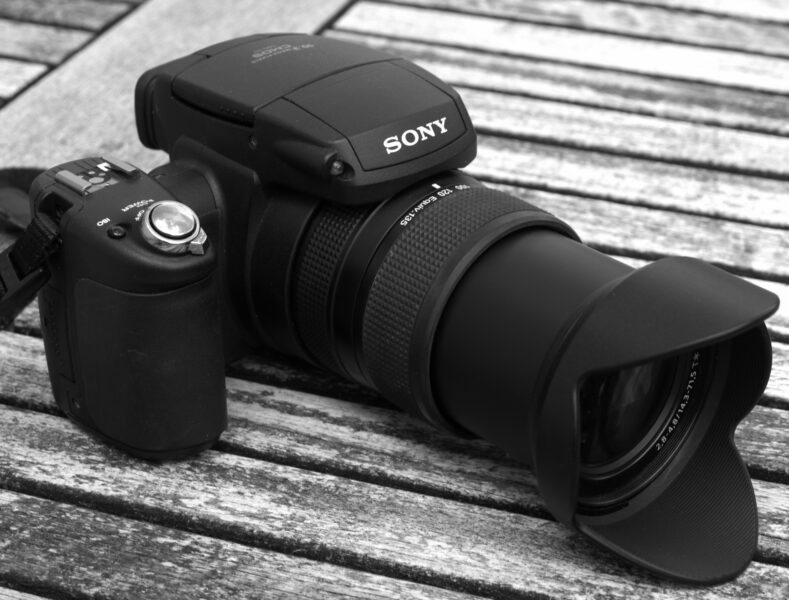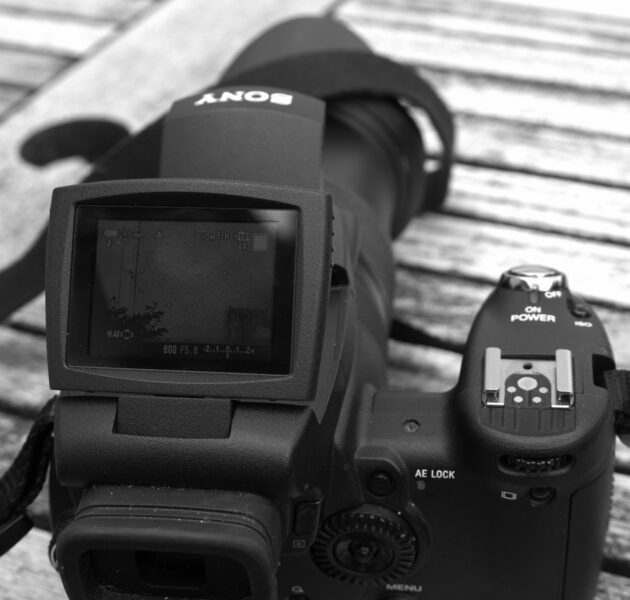This was a camera that I quite fancied when it was new in 2005, but it was quite expensive at that time – £800, and I had my sights set on Minolta’s long awaited DSLR, the Dynax 5D. I already had a set of lenses for the D5D as it used a Minolta A mount and I’d managed to collect a good few of these around 2004 when film was dying and Minolta had no digital body so prices were very keen. And I already had 505Si and 800Si film bodies.
The DSC-R1 only had a fixed lens so my lens collection wouldn’t work with it. However, what a lens it was, a 24-120mm equivalent f2.8-4.8 carrying the Carl Zeiss Vario-Sonnar T* designation.
History took a strange turn at this point. Almost immediately after I bought my D5D, Sony bought out the whole of Konica Minolta’s camera division with a view to developing their own DSLR range. At this point the R1 was scrapped as it obviously intruded on Sony’s intended market. Konica Minolta had been working on a Mk2 version of the Dynax 5D and this was brought into production as the Sony DSLR-A100 and later on the Dynax 7D was replaced with a “Mk2″ version called the Sony DSLR-A700. I would end up owning both of those cameras! But the R1 was finished after only a year and not replaced – at least until the RX10 range with 1” sensors came out from 2014 onwards.
In 2012 I had the opportunity to buy a used R1 in pretty much mint condition for £140 so I did it and have had many happy outings with this camera since.
So what is it? Well it’s big chunky lump of a camera, very solid with a good range of controls including a manual zoom on the lens – 5x 24-120mm equivalent. Uniquely for a bridge camera it has an APS-C sized sensor. Actually not quite, it’s a bit smaller being a 1.7x crop, but close. Bigger than a Micro 4/3rds sensor. It has an EVF of low resolution but quite usable, a very unconventional twirly screen mounted on top of the EVF allowing selfie views, waist-level viewing and pretty much any angle in between as well as side-on viewing if you need to. This means the hot shoe – an ISO type, is relegated to the top of the grip which is a bit strange.



Most of the camera controls including the Mode dial and two control dials are on the back of the camera with various buttons and switches with grip housing just the on/off switch around the shutter release and the ISO button next to it. There are focus controls on the left of the body including a nice “back button” focus setup, though it’s not on the back, and a white balance button that always works well on AWB. On the right is the CF (yes, CF) card slot and also a space for a Memory Stick which I’ve never used.
On the bottom is the battery compartment – a Sony NP-FM50 type which are plentiful and also hold plenty of juice. There is also a 1/4″ tripod screw which is, usefully, on the lens axis.



Using this camera involves a learning curve as it is so far off the beaten track compared to the kind of layout that has become conventional now. This is anything but conventional, it is quirky. Very quirky. But once mastered it is very rewarding to use, and even by the standards of 17 years later that nice big sensor and that glorious Carl Zeiss lens means that its picture quality still cuts the mustard in 2022!
However it is still a 2005 camera and the most obvious side effect of that is that it’s slow. Very, very slow in fact. Particularly if you shoot RAW in which case the 20MB files take 9 secs to save during which time the camera freezes. So I mostly shoot jpg only as they’re pretty much right straight out of the camera. The RAWs are better though. There is no buffering in RAW and only three frames in jpg then a 9 second wait before you can shoot again. It shows its age here.
Also, despite the nearly APS-C sensor, image quality is only great until ISO400, then it gets noisy. RAWs do better, with a bit of care a nice image can be got at ISO 1600. The 3200 setting was only put there by the marketing people, it is best left alone. There is no stabilisation in the camera at all so you do have to be a bit careful with shutter speeds although the fact that it weighs 1kg give or take a few grams and the quality of the grip means that it is not hard to hold still.
The focusing is of its time – Contrast detect, hunts around a bit but generally gets it right. The lower the light, the slower it goes. No tracking or anything fancy. Also note the camera has no video mode. One plus – the leaf shutter is very quiet and the camera does real flash sync – no HSS trickery – right up to it’s fastest speed of 1/2000th. On the matter of the flash, the internal unit is quite bright, but remember to remove the lens hood when using it or a shadow will appear in the lower part of the picture!
So here’s a selection of pictures, all slightly cropped and straightened but otherwise out-of-camera jpgs no colour, levels, contrast or sharpness etc adjustments using the camera’s “standard modes.
I have thoroughly enjoyed this camera and would recommend it if you can find a good one at the right price!






























